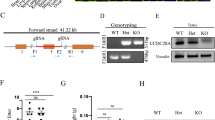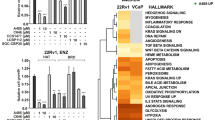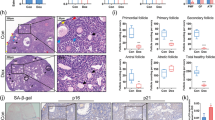Abstract
Objective and design
The proinflammatory cytokine tumor necrosis factor alpha (TNF-α) has an inhibitory role in gonadal functions particularly in the steroidogenesis of Leydig cells. A detailed understanding of the mechanisms by which TNF-α regulates testicular steroidogenesis will be helpful in the design of novel clinical interventions for the treatment and prevention of male reproductive disorders. Here, we report that TNF-α-mediated activation of DAX-1 (dosage-sensitive sex reversal adrenal hypoplasia congenital critical region on X chromosome, gene 1) is involved in the inhibition of Leydig cell steroidogenesis.
Materials and methods
Rat testis Leydig tumor cells (LC-540) were treated with TNF-α (10 ng/ml) for different time intervals. To elucidate the pathways of intracellular signal transduction that regulate DAX-1 expression, we utilized specific inhibitors. The siRNA transfection of DAX-1 into LC-540 cells was performed by electroporation. The mRNA and protein levels were determined by RT-PCR and Western blotting, respectively.
Results
We found that the mRNA and protein levels of DAX-1 were increased by threefold approximately in TNF-α-treated cells when compared to controls. Staurosporine, JNK inhibitor SP600125 and ERK inhibitor PD98059 significantly decreased DAX-1 expression in TNF-α-treated Leydig cells when compared to their respective controls. Further, a siRNA-mediated knockdown of DAX-1 restores the expression of steroidogenic proteins in TNF-α-treated Leydig cells.
Conclusions
These findings provide valuable information that TNF-α activates DAX-1 through JNK/ERK MAP kinase pathway which regulates the expression of steroidogenic enzyme genes in Leydig cells.






Similar content being viewed by others
References
Walker WH. Testosterone signaling and the regulation of spermatogenesis. Spermatogenesis. 2011;1:116–20.
McLachlan RI, O’Donnell L, Meachem SJ, Stanton PG, de Kretser DM, Pratis K, Robertson DM. Identification of specific sites of hormonal regulation in spermatogenesis in rats, monkeys, and man. Recent Prog Horm Res. 2002;57:149–79.
Hales DB. Testicular macrophage modulation of Leydig cell steroidogenesis. J Reprod Immunol. 2002;57:3–18.
Bornstein SR, Rutkowski H, Vrezas I. Cytokines and steroidogenesis. Mol Cell Endocrinol. 2004;215:135–41.
Hong CY, Park JH, Ahn RS, Im SY, Choi HS, Soh J, Mellon SH, Lee K. Molecular mechanism of suppression of testicular steroidogenesis by proinflammatory cytokine tumor necrosis factor alpha. Mol Cell Biol. 2004;24:2593–604.
Calkins JH, Guo H, Sigel MM, Lin T. Tumor necrosis factor-alpha enhances inhibitory effects of interleukin-1 beta on Leydig cell steroidogenesis. Biochem Biophys Res Commun. 1990;166:1313–8.
Suescun MO, Rival C, Theas MS, Calandra RS, Lustig L. Involvement of tumor necrosis factor-alpha in the pathogenesis of autoimmune orchitis in rats. Biol Reprod. 2003;68:2114–21.
Xiong Y, Hales DB. The role of tumor necrosis factor-alpha in the regulation of mouse Leydig cell steroidogenesis. Endocrinology. 1993;132:2438–44.
Xiong Y, Hales DB. Differential effects of tumor necrosis factor-alpha and interleukin-1 on 3 beta-hydroxysteroid dehydrogenase/delta53delta 4 isomerase expression in mouse Leydig cells. Endocrine. 1997;7:295–301.
Lalli E. Role of orphan nuclear receptor DAX-1/NR0B1 in development, physiology, and disease. Adv Biol. 2014;2014:582749.
Yu RN, Ito M, Saunders TL, Camper SA, Jameson JL. Role of Ahch in gonadal development and gametogenesis. Nat Genet. 1998;20:353–7.
Lalli E, Melner MH, Stocco DM, Sassone-Corsi P. DAX-1 blocks steroid production at multiple levels. Endocrinology. 1998;139:4237–43.
Wallach D, Varfolomeev EE, Malinin NL, Goltsev YV, Kovalenko AV, Boldin MP. Tumor necrosis factor receptor and Fas signaling mechanisms. Annu Rev Immunol. 1999;17:331–67.
Aggarwal BB. Signalling pathways of the TNF superfamily: a double-edged sword. Nat Rev Immunol. 2003;3:745–56.
Burkhard K, Shapiro P. Use of inhibitors in the study of MAP kinases. Methods Mol Biol. 2010;661:107–22.
Karaman MW, Herrgard S, Treiber DK, Gallant P, Atteridge CE, Campbell BT, Chan KW, Ciceri P, Davis MI, Edeen PT, Faraoni R, Floyd M, Hunt JP, Lockhart DJ, Milanov ZV, Morrison MJ, Pallares G, Patel HK, Pritchard S, Wodicka LM, Zarrinkar PP. A quantitative analysis of kinase inhibitor selectivity. Nat Biotechnol. 2008;26:127–32.
Lee J, Rhee MH, Kim E, Cho JY, BAY 11-7082 is a broad-spectrum inhibitor with anti-inflammatory activity against multiple targets. Mediat Inflam. 2012;2012:416036.
Guo C, Wang SL, Xu ST, Wang JG, Song GH. SP600125 reduces lipopolysaccharide-induced apoptosis and restores the early-stage differentiation of osteoblasts inhibited by LPS through the MAPK pathway in MC3T3-E1 cells. Int J Mol Med. 2015;35:1427–34.
Cuenda A, Rouse J, Doza YN, Meier R, Cohen P, Gallagher TF, Young PR, Lee JC. SB 203580 is a specific inhibitor of a MAP kinase homologue which is stimulated by cellular stresses and interleukin-1. FEBS Lett. 1995;364:229–33.
Alessi DR, Cuenda A, Cohen P, Dudley DT, Saltiel AR. PD 098059 is a specific inhibitor of the activation of mitogen-activated protein kinase kinase in vitro and in vivo. J Biol Chem. 1995;270:27489–94.
Wu L, Xu B, Fan W, Zhu X, Wang G, Zhang A. Adiponectin protects Leydig cells against proinflammatory cytokines by suppressing the nuclear factor-κB signaling pathway. FEBS J. 2013;280:3920–7.
Wu L, Zhang A, Sun Y, Zhu X, Fan W, Lu X, Yang Q, Feng Y. Sirt1 exerts anti-inflammatory effects and promotes steroidogenesis in Leydig cells. Fertil Steril. 2012;98:194–9.
Prahalathan C, Selvakumar E, Varalakshmi P. Modulatory role of lipoic acid on adriamycin-induced testicular injury. Chem Biol Interact. 2006;160:108–14.
Le Boeuf F, Houle F, Huot J. Regulation of vascular endothelial growth factor receptor 2-mediated phosphorylation of focal adhesion kinase by heat shock protein 90 and Src kinase activities. J Biol Chem. 2004;279:39175–85.
Tremblay PL, Auger FA, Huot J. Regulation of transendothelial migration of colon cancer cells by E-selectin-mediated activation of p38 and ERK MAP kinases. Oncogene. 2006;25:6563–73.
Peister A, Mellad JA, Wang M, Tucker HA, Prockop DJ. Stable transfection of MSCs by electroporation. Gene Ther. 2004;11:224–8.
Diemer T, Hales DB, Weidner W. Immune-endocrine interactions and Leydig cell function: the role of cytokines. Andrologia. 2003;35:55–63.
Diemer T, Allen JA, Hales KH, Hales DB. Reactive oxygen disrupts mitochondria in MA-10 tumor Leydig cells and inhibits steroidogenic acute regulatory (StAR) protein and steroidogenesis. Endocrinology. 2003;144:2882–91.
Calandra T, Baumgartner JD, Grau GE, Wu MM, Lambert PH, Schellekens J, Verhoef J, Glauser MP. Prognostic values of tumor necrosis factor/cachectin, interleukin-1, interferon-alpha, and interferon-gamma in the serum of patients with septic shock. Swiss-Dutch J5 Immunoglobulin Study Group. J Infect Dis. 1990;161:982–7.
Cannon JG, Tompkins RG, Gelfand JA, Michie HR, Stanford GG, van der Meer JW, Endres S, Lonnemann G, Corsetti J, Chernow B, et al. Circulating interleukin-1 and tumor necrosis factor in septic shock and experimental endotoxin fever. J Infect Dis. 1990;161:79–84.
Damas P, Reuter A, Gysen P, Demonty J, Lamy M, Franchimont P. Tumor necrosis factor and interleukin-1 serum levels during severe sepsis in humans. Crit Care Med. 1989;17:975–8.
Vogel AV, Peake GT, Rada RT. Pituitary-testicular axis dysfunction in burned men. J Clin Endocrinol Metab. 1985;60:658–65.
Woolf PD, Hamill RW, McDonald JV, Lee LA, Kelly M. Transient hypogonadotropic hypogonadism caused by critical illness. J Clin Endocrinol Metab. 1985;60:444–50.
Mealy K, Robinson B, Millette CF, Majzoub J, Wilmore DW. The testicular effects of tumor necrosis factor. Ann Surg. 1990;211:470–5.
van der Poll T, Romijn JA, Endert E, Sauerwein HP. Effects of tumor necrosis factor on the hypothalamic-pituitary-testicular axis in healthy men. Metabolism. 1993;42:303–7.
Crawford PA, Dorn C, Sadovsky Y, Milbrandt J. Nuclear receptor DAX-1 recruits nuclear receptor corepressor N-CoR to steroidogenic factor 1. Mol Cell Biol. 1998;18:2949–56.
Song KH, Park YY, Park KC, Hong CY, Park JH, Shong M, Choi HS. The atypical orphan nuclear receptor DAX-1 interacts with orphan nuclear receptor Nur77 and represses its transactivation. Mol Endocrinol. 2004;18:1929–40.
Holter E, Kotaja N, Ma¨kela S, Strauss L, Kietz S, Ja¨nne OA, Gustafsson JA, Palvimo JJ, Treuter E. Inhibition of androgen receptor (AR) function by the reproductive orphan nuclear receptor DAX-1. Mol Endocrinol. 2002;16:515–28.
Ahn SW, Gang GT, Kim YD, Ahn RS, Harris RA, Lee CH, Choi HS. Insulin directly regulates steroidogenesis via induction of the orphan nuclear receptor DAX-1 in testicular Leydig cells. J Biol Chem. 2013;288:15937–46.
Shimizu T, Sudo N, Yamashita H, Murayama C, Miyazaki H, Miyamoto A. Histone H3 acetylation of StAR and decrease in DAX-1 is involved in the luteinization of bovine granulosa cells during in vitro culture. Mol Cell Biochem. 2009;328:41–7.
Acknowledgments
The authors gratefully acknowledge Indian Council of Medical Research (ICMR), New Delhi, India for the financial assistance. The infrastructure provided by DST-FIST is also gratefully acknowledged.
Author information
Authors and Affiliations
Corresponding author
Additional information
Responsible Editor: Andrew Roberts.
Electronic supplementary material
Below is the link to the electronic supplementary material.
11_2015_835_MOESM1_ESM.tif
Supplementary material 1 LC-540 cell viability is affected by TNF-α in a dose- a and time- b dependent manner. Values represent mean ± SD for 3 independent experiments (n=3). Values are statistically significant at *** P < 0.001, **P < 0.01 and * P < 0.05 (TIFF 153 kb)
11_2015_835_MOESM2_ESM.tif
Supplementary material 2 Effect of NF-κB inhibitor on DAX-1 protein levels in LC-540 Leydig cells cells. LC-540 Leydig cells were pretreated with BAY11-7082 (10µM) for 60min and then treated with or without TNF-α (10ng/ml) and used for the analysis of DAX-1 protein expressions. β-actin levels were utilized as internal control. Values represent mean ± SD for 3 independent experiments (n=3). Values are statistically significant at *** P < 0.001 (TIFF 150 kb)
Rights and permissions
About this article
Cite this article
Sadasivam, M., Ramatchandirin, B., Balakrishnan, S. et al. TNF-α-mediated suppression of Leydig cell steroidogenesis involves DAX-1. Inflamm. Res. 64, 549–556 (2015). https://doi.org/10.1007/s00011-015-0835-8
Received:
Revised:
Accepted:
Published:
Issue Date:
DOI: https://doi.org/10.1007/s00011-015-0835-8




